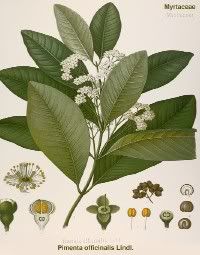

Allspice (Pimenta officinalis, P dioica)
Folk Names: Clove Pepper, Jamaica Pepper, Pimento
Pimenta officinalis : The dried unripe berry of the pimento evergreen tree is the allspice berry used in a variety of foods. The tree grows up to 50 feet in West Indies, South and Central America, and Mexico. The leaves are opposite, leathery, and oblong to oblong-lanceolate with prominent pinnate veins underneath. Small white flowers cluster in cymes in the upper leaf axils June through August. The berry is fleshy and sweet, purplish-black or dark-brown when ripe. Pimenta dioica grows from Central America and Mexico to Jamaica. This species is slightly smaller at a maximum height of 33 feet. The flexible trunk has silver-gray bark and many thin branches. The leaves of P dioica are oblong-acuminate. The little whitish flowers also grow in cymes and are generally apical though sometimes axillary. The flowers have four to five petals, and the calyx has four lobes distinguishing it from other species. The globose fruits are very small.
Effects: Strong
Planet: Mars
Element: Fire
Associated Deities:
Traditions:
Allspice was one of the spices Columbus brought back to Europe on his first trip. It was named by John Ray (1627-1705), an English botanist, who compared its taste to a combination of cinnamon, nutmeg, and cloves. The Aztecs used it to flavor chocolate.
Magic:
Allspice may be added to incense designed to attract money or luck. It may also be included in money and luck mixtures. The berries have been used in love spells and sachets. They also inspire love when eaten. Spells to promote healing may also include allspice.
Known Combinations:
As an aphrodisiac, allspice may be added when making chocolate confections.
Medical Indications: Parts Used : dried berries
Allspice is an aromatic, carminative, stimulant, and anesthetic.
Pimento water or oil is used for flatulence. The oil has also been put to use in calming hysterical spasms and added laxatives to lessen gripe.
An ointment of allspice acts as an anesthetic and antiseptic, and a small amount of grated herb may be added to the bath as well. For rheumatism and neuralgia, allspice may be added to a plaster.
Nutrition:
Allspice may be used in cakes, cookies, pies, puddings and custards, fruit desserts, pickling, spiced syrups and mulled wines, and rose flavored confections. It may be used with beef, lamb, fish, and in stews and pot roasts. The powder has been added to curry and as season for shellfish. Red cabbage dishes, sweet potatoes, and beets are some vegetables allspice compliments.
The leaves are used to flavor bay rum, and the flowers may be infused into a tea.
The berries may be purchased whole or ground. As with any herb, it is better buy it whole. Ground spices may be commercially cut with sawdust to extend the supply. They also lose their potency faster than whole herbs. Whole herbs may be ground at need in a mill or a mortar and pestle.
Mercantile Uses:
Allspice is cultivated in Jamaica on plantations known as Pimento Walks. In addition to being a much used food spice, the scent is used in potpourris.